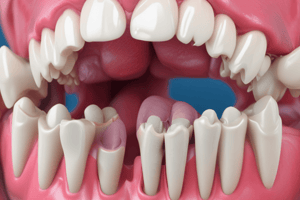Podcast
Questions and Answers
The external surface of the attached gingiva is ______ mucosa.
The external surface of the attached gingiva is ______ mucosa.
masticatory
The attached gingiva is typically ______, though the degree of keratinization is variable.
The attached gingiva is typically ______, though the degree of keratinization is variable.
keratinized
Parakeratinized areas stain strongly pink with ______ and eosin.
Parakeratinized areas stain strongly pink with ______ and eosin.
haematoxylin
The connective tissue ______ beneath the epithelium are variably arranged, often in rows.
The connective tissue ______ beneath the epithelium are variably arranged, often in rows.
The surface of the attached gingiva is ______, caused by intersecting epithelial ridges.
The surface of the attached gingiva is ______, caused by intersecting epithelial ridges.
There is no ______ in the attached gingiva; the lamina propria is directly bound to the bone.
There is no ______ in the attached gingiva; the lamina propria is directly bound to the bone.
Orthokeratinization occurs in healthy, non-inflamed gingiva, while ______ can occur with visible nuclei.
Orthokeratinization occurs in healthy, non-inflamed gingiva, while ______ can occur with visible nuclei.
The direct attachment to the bone creates a firm and ______ gingiva.
The direct attachment to the bone creates a firm and ______ gingiva.
Study Notes
Masticatory Mucosa
- The outer surface of the attached gingiva is masticatory mucosa.
- It's adapted to withstand chewing forces.
- This provides protection for the gingiva during mastication.
Keratinization
- The attached gingiva is usually keratinized, but the level varies.
- Healthy, non-inflamed gingiva shows orthokeratinization, with no visible nuclei in the keratinized cells.
- But parakeratinization, with visible nuclei, can happen in up to 75% of cases.
- Keratinization acts as a protective barrier, and its variability reflects the response to inflammation or mechanical stress.
Staining Characteristics
- Parakeratinized areas stain strongly pink with hematoxylin and eosin.
- This helps identify the level of keratinization and provides insights into the health of the gingival tissue.
Papillation and Papillae Arrangement
- The connective tissue papillae beneath the epithelium have variable arrangements, often in rows.
- This increases the surface area for nutrient exchange between the epithelium and connective tissue.
- It also strengthens the attachment between the gingival epithelium and underlying bone, which contributes to gingival stability.
Stippling
- The surface of the attached gingiva is stippled due to intersecting epithelial ridges.
- Stippling is a sign of healthy attached gingiva, reflecting its robust attachment to underlying tissues.
- It's a clinical indicator of the gingiva's health and integrity.
Absence of Submucosa
- The attached gingiva lacks submucosa.
- The lamina propria is directly bound to the bone, forming a mucoperiosteum.
- This direct attachment to the bone creates a firm and immovable gingiva.
- It contributes to gingival stability, preventing movement during mastication, which is crucial for maintaining periodontal health.
Studying That Suits You
Use AI to generate personalized quizzes and flashcards to suit your learning preferences.
Description
Explore the characteristics of masticatory mucosa, focusing on the attached gingiva. This quiz covers aspects of keratinization, staining characteristics, and papillae arrangement, providing insights into gingival health and adaptation to mastication.



